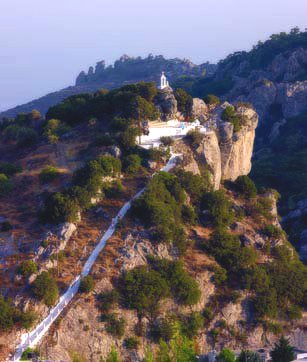One of the most beautiful parts of Ierapetra's hinterland is occupied by the picturesque village of Kalamafka. It is situated on the edge of the Lassithi mountains, an area with impressive diversity in its landscape, at an altitude of 480 metres, 15km from the town of Ierapetra and 25km from Agios Nikolaos.
Kalamafka is a picturesque, large and wealthy village, with surroundings of unique natural beauty.
The springs at Kefalovryso (GR:Κεφαλόβρυσο) with the plane trees and the lush vegetationold historical churches, gorges, springs and which attracts visitor from maintain its population due the keeps its residents the springs at Kefalovryso set in lush vegetation, looks like an oasis of coolness in our dry and hot province.
Its wealth is its water and the vigorousness of its residents, who resist urbanism. The fact that the residents of Kalamafka stay at
their place of birth is also due to the advantageous position of the village since it is in the middle of the distance between the north and the south coast of our island and daily attracts visitors from Ierapetra and Agios Nikolaos.
History
The village took its name from Kali Afkla, which was a channel made of wood at the springs of Kefalovryso that used to transfer water from one river bank to another.
Another explanation is that the rock on the Kastelos hill which looks like a Greek Orthodox priest's hat (kalymafki), gave the name to the village.
Kalamafka, ancient Larisa, has been inhabited even since the Minoan era.
In the site Psathi, situated on the road to Ierapetra, human sculls, clay pots, spearheads, various grave goods of the sub-minoan era were found. The geographer Strabo writes about Kalamafka, ancient Larisa: "And in Crete there is the city of Larisa, which now is united with Ierapytna, and from which the plain below, called Larision, takes its name."
The god protector of ancient Larisa was Asclepius, and because of this the Medical Association of Lassithi has made its emblem the figure of the statuette discovered on the Kastelos peak, which dominates over the village and was a peak sanctuary, according to Mr. Michalis Pytikakis. Larisa has been subdued around the 3rd century B.C. by Ierapytna. Its residents were deported elsewhere according to the signed treaty. During the following historical periods, there is evidence that the area of Kalamafka, because of the existence of the water sources of Kefalovryso has been inhabited uninterruptedly. The place names Kastelos, Mesokastela, Larisakia prove its flourishing.


Kastelos Hill
Being the seat of a feudal lord during the Venetian rule, it had 435 residents in 1583. It had great Byzantine and post-byzantine churches and many chapels. During the Turkish rule it bred great chieftains, such as Nikolaos Foniadakis and Ioannis Baritakis. The evidence of its history, struggles and sacrifices cannot be summarized.
Today, Kalamafka is the liveliest village, as its population grows, it has a two-seat school, a nursery school, a cultural association, a lot of coffee houses and 7 taverns.
Its natural landscape that has been called "Chinese", because of the small rock pillars with bonsais, stone gods, Kastelos, with the 224 steps, has been characterized as a monument of natural history. The caves, the rock paintings, the Havgas gorge, the ancient olive press, the churches of Saint John and Saint Anthony are some of the many places to see in Kalamafka.
The taverns with the plane trees and the running waters, the traditional, local delicious dishes, the traditional "klostenios" halva and the skyfomakarounes (local pasta), with the sounds of lyra, violin and lute satisfy both locals and foreigners. There are then a lot of reasons to visit Kalamafka.
Source:The municipality of Ierapetra
Photos